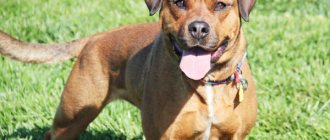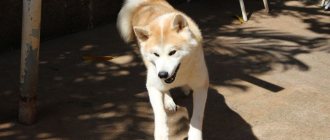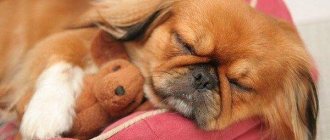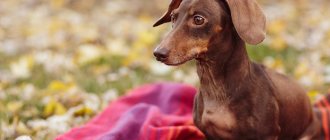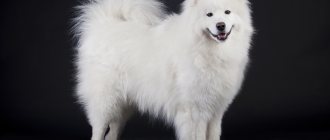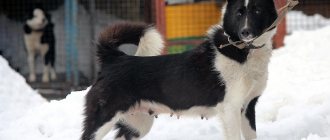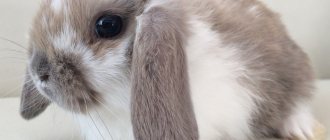The main features characteristic of the Rottweiler dog breed:
- It is distinguished by a developed mind, self-esteem, and increased endurance.
- Large and muscular, has powerful jaws. A dog’s attack is difficult to repel even for a trained person.
- Does not tolerate heat well, thanks to its thick undercoat it is not afraid of frost, and is tolerant of pain.
- Requires the firm hand of a strict leader with a strong character.
- Disadvantages include laziness, desire to dominate, love of sleeping in the master's bed, willfulness, stubbornness, and cunning.
- Does not tolerate violence.
- Able to independently assess the situation, make a decision and act with lightning speed.
- Athletic, requires increased activity and long walks.
- Needs training exclusively under the guidance of a professional, otherwise he will grow up aggressive and uncontrollable.
- Cannot exist without service, physical and emotional stress.
- He has an excellent appetite, is almost omnivorous, and therefore prone to obesity.
- Susceptible to genetic, cardiovascular, skin diseases, eye diseases, joint dysplasia and bloating.
In the city of Rottweil (Germany), which gave the name to the breed, a bronze monument to the valiant and faithful dog was erected in 2007.
Characteristics of the Rottweiler breed: pros and cons
Male:
Bitch:
Price:
Life expectancy is 11 – 12 years. |
Who is the breed suitable for? Who won't suit it? | Suitable:
Will not work:
|
How do you treat other pets and dogs while walking? | Generally calm, but requires socialization. Pets that they grew up with are treated as members of the pack, and are treated with patronage. Small breed dogs are not noticed on walks. Large individuals can challenge them, so it is important to achieve complete control over the animal and its obedience to the owner. |
How often and for how long should you walk? | At least two to three visits per day for an hour. Walking must necessarily include active outdoor games. Regular training sessions and sports are required: Frisbee, running, swimming, weight-pulling, puller-running, puller-jumping, agility. If the dog lives in an apartment, it is necessary to organize a trip to the country, to nature or to the forest at least once a week. |
Is it possible to keep it on a chain in the yard? | No. This is unacceptable for a Rottweiler. During the daytime he is kept in the yard, but under protection from heat and dampness. At night, he must be close to the owner in order to perform his main functions - to guard and protect. |
Is it possible to keep it in an apartment? | Yes, this is possible subject to regular walking and appropriate physical activity. |
How to care for wool? Does it shed a lot? | Coat care is simple: comb it once a week, removing dead hair with a comb or massage brush. Heavy molting is not typical for healthy individuals, even in the off-season. During this period, comb your pet twice as often. |
How often should I bathe? | Once every six months is enough. Use a quality shampoo for short-haired dogs. In rainy weather, you can wipe the dirty rotti with a damp towel. |
Attitude towards children | Gets along with children of any age, provided that they are members of the household. It is potentially dangerous for other people's children, as it may perceive playing, running and screaming as a threat to their children. Communication with a young child requires the presence of adults due to the slowness of the breed. It can awkwardly turn around and crush or push the baby. |
Purpose of the breed. What services is it suitable for? | According to the description of the breed, the Rottweiler is a companion, bodyguard, and security guard. Can be used as draft force. Can serve in the police, be a rescuer, or a guide. |
Is he sometimes aggressive? | Yes, when attacking the owner. It is almost impossible to stop a defending Rottweiler. But it is important to understand that the breed itself is not aggressive. A dog attacks without reason only in case of improper upbringing, poor training, or lack of control and management on the part of the owner. |
What to feed your Rottweiler? | Dry balanced or natural food. Mixing is unacceptable. The size of portions and calorie content of food depends on the age and health of the dog, and the level of physical activity. Adults should be fed at the same time, in small portions, 3 to 4 times a day. |
The advantages of the breed include:
- A stable, balanced psyche.
- High intelligence.
- Reliable property guard and bodyguard.
- Devotion.
- Easy to care for hair.
- Not annoying or intrusive. Knows how to keep himself busy.
- Sheds moderately.
In 1999, the Rottweiler Orion saved the lives of thirty-seven people by pulling their water during a flood in Venezuela.
Minuses:
- A strong dominant character that can only be controlled by an owner who has earned trust and respect.
- It is a potentially dangerous dog, which imposes increased responsibility on the owner in raising and walking it.
- It is clumsy due to its large dimensions and weight, which can cause difficulties in maintenance.
- Requires a complete balanced diet, which entails significant financial costs.
- Cunning due to natural intelligence.
- Increased salivation.
- Does not tolerate heat well.
- Sometimes he snores and coughs in his sleep.
In 2002, Swiss dog handlers did a lot of work to collect statistics on Rottweiler attacks on people. According to the results, it turned out that, indeed, this breed, second only to the German Shepherd, bites people more often than others. The pressure of a Rottweiler's jaws when biting reaches 22 atmospheres.
How to feed a Rottweiler correctly
A dog’s diet is the second important point after upbringing and training. How long Rottweilers live at home depends on the quality of the diet and the correct feeding regimen. And they live a long time: with good care, up to 12 years.
Basic feeding rules
Veterinarians and breeders advise following the following recommendations:
- A bowl of clean water should always be within the dog's reach.
- If food remains after eating, it must be removed. The next portion should be given at the next feeding time.
- You should not change the brand of food unless necessary. In case of allergies or food intolerance, new food should be introduced gradually, replacing some of the familiar food with new food.
Types of feed
The Rottweiler's diet should be varied. You can feed dry food or natural food:
- Dry food. The main advantages of industrial food are a balanced combination of ingredients and saving the owner’s time on preparing food for the dog. Food should be purchased at least premium. They are of higher quality compared to inexpensive analogues and can provide the Rottweiler with all the necessary nutrients for a full and healthy life.
- Natural food. The main part of the food is meat and offal. In addition to them, sources of protein for your pet can be fermented milk products, eggs, and low-fat fish. The Rottweiler gets carbohydrates from rice and buckwheat, and fiber from vegetables. Prohibited foods are sweets, milk, and tubular bones.
Description of the breed: character and temperament
Representatives of the breed are usually sanguine in temperament. They are optimistic, friendly and playful with the family they live with. They love games and have a sense of humor.
The Rottweiler is, first and foremost, a rock-solid and fearless protector. He is extremely vigilant and cautious towards strangers. In the heat of rage, the breed is deadly, but this only applies to strangers. The dog protects his family, perceived as a pack of which he is a member, like the apple of his eye. It is impossible to bribe him, to appease him with a treat or anything else.
The breed is considered a one-owner dog. People of weak character, and especially those who are amateurs in raising large fighting dogs, should not acquire such a pet. The Rottweiler is complex in character: he will obey only a leader who has earned and justified his trust, a strong and self-sufficient personality. That is why it will be difficult for a woman or child to achieve obedience to a rotti.
The dog has a very subtle sense of relationships in the family. Strife, scandals and showdowns have the most negative impact on his psyche and can result in chronic aggression towards everyone indiscriminately, uncontrollable behavior and even attacks on family members. But a well-bred Rottweiler, raised in a friendly atmosphere, is a faithful friend until his last breath. He desperately loves children of any age and is ready to protect them even from their peers.
Before guests arrive, it is better to send your pet to another room and close the door behind it. The slightest reason, a hint of a threat, and the dog will turn into an angry fury. He is extremely vigilant, careful and attentive, hears the slightest rustle and is swift in attack.
The character flaws of the Rottweiler dog include stubbornness, jealousy of the owner, and willfulness. If you relax at least a little and allow him a little extra, the smart dog will quickly find weak points and begin not just to put pressure on them, but to openly manipulate you, try to dominate and take the place of leader.
The Rottweiler is one of the twenty most popular dog breeds in America.
Brief description of the breed
The Rottweiler is a large breed. The weight of an adult dog is more than 42 kg, and its height ranges from 56-68 cm depending on the sex of the animal.
By all standards, the color of the dog should be black with red tan. Other options do not meet the breed requirements.
By nature, the Rottweiler is cunning, soft and affectionate; it is sometimes even compared to a cat, but only for members of its family. If he feels seriously threatened, he will turn into a ruthless protector of the pack (family).
Considering that the dog’s instinct to protect its owner comes first, it must be trained to avoid the manifestation of causeless aggression. The Rottweiler is easy to train, you just need to overcome its natural laziness. In addition to training, do not forget about the early socialization of the dog.
If a person does not have experience raising this type of dog, then they should entrust the dog to a professional or think about choosing a different breed.
Rottweiler photo
Care and maintenance
Caring for and maintaining a Rottweiler is extremely simple. They are as follows:
- Combing the coat once or twice a week.
- Bathing two to three times a year.
- Vaccinations.
- Washing paws after a walk if the dog is kept in an apartment.
- Wiping wool with a terry towel in rainy weather.
- Treatment for parasites.
- Nail trimming if necessary (may be needed in rare cases).
- Clean your ears weekly with a dry swab, or you can soak it in sea buckthorn oil or alcohol-free lotion.
- Inspection and cleaning of teeth once a week - performed with a gauze swab with soda (you can give the dog special bones from beef veins to clean the teeth).
When keeping a dog in a private home, it is necessary to have a spacious enclosure. But even living in an enclosure, the animal needs walks outside its territory. When the temperature is below 10 degrees, it is important to take the dog home.
Deworming is carried out once a month until the child is 6 months old. Then once a quarter. The best drugs are Drontal Plus, Milbemax, Kanikvantel. Treatment against fleas with special drops is carried out once a month from May to October.
Vaccination is carried out according to a standard scheme, which is repeated annually:
- At 4 – 6 weeks.
- At 8 or 9 weeks
- At 3 months.
10 days before vaccination, worms are removed.
It is important for Rottweilers kept outside the city to be vaccinated against ringworm.
From puppyhood, teach your pet to be patient with hygiene procedures and to stand calmly during their process. This will allow you to avoid an unpleasant situation at an older age, when you have to hold a 50-kilogram dog with the whole family while bathing or cleaning your ears.
Caring for an adult dog
Basic care for an adult Rottweiler consists of regular, long walks, active games and balanced feeding, taking into account age and health status.
Regular hygiene procedures are required:
- eye and coat care;
- bathing;
- trimming nails if necessary;
- regular oral examination;
- cleaning teeth and ears.
You also need to promptly deworm and treat for external parasites and vaccinate your pet according to the schedule drawn up by the veterinarian.
Expert opinion
Tolkachev Andrey Mikhailovich
veterinarian
The main thing that Rottweilers need is a balanced diet and the necessary nutritional supplements. They also need proper physical activity. To avoid problems with the musculoskeletal system, a dog up to 8 months should not jump higher than the height of its own elbow, up to a year should not take hurdles, and up to 1.5 years should not run after a bicycle or owner. Your veterinarian should give more detailed recommendations during a routine examination.
Feeding
When talking about what to feed your Rottweiler, most breeders recommend alternating dry food with natural food. Using high-quality dry food is convenient because you do not need to calculate the vitamin content of each serving, the ratio of vegetables and cereals to meat or milk share. Meals are calculated and balanced in advance. But at the same time, an animal that receives only drying will not be as well-groomed, naturally, with such gloss as when fed naturally. The highest quality dry foods that have won an excellent reputation are Hill's, Royal Canin, Eukanuba, Purina Pro Plan, Ist Choice, Eagle Pack.
In what cases is it better to feed your Rottweiler only dry food:
- Rehabilitation after illness.
- Pregnancy and lactation.
- A period of active growth.
The diet of adults should consist of:
- Dry food (pre-soak).
- Cereals - rice, oatmeal or buckwheat, can be combined (it is important that they are well boiled).
- Meat - beef, chicken, turkey (necessarily boiled).
- Fish – sea fish, boneless fillet (boiled).
- By-products – kidneys, beef tripe, heart, esophageal meat (boiled).
- Cottage cheese and cheese, preferably homemade - twice a week.
- Chicken eggs - one twice a week.
- Vegetables - pumpkin, onions, zucchini, carrots (stew in sunflower oil, preferably olive).
- Fruits – a little, only as a treat.
- Mosli and sugar bones without meat residue - for cleaning teeth and as a delicacy.
Prohibited products:
- Salty foods.
- Tubular bones.
- Milk.
- Pork.
- Pasta.
- Semi-finished products.
- Semolina.
- Any baked goods.
- Canned food.
- Marinades, pickles, smoked meats.
- Sugar and its substitutes.
- Potato.
- Beet.
- Bell pepper.
- Cabbage.
- Legumes.
- Remains of “human” food.
It is better to feed at the same time every day. In the evening - until 19:00, so as not to burden the animal’s stomach before bedtime. It is important that the dog has access to cool water at all times (for puppies it should be boiled, for adults it should be settled or filtered). Adults also need to have one fasting day every week - feed only fermented milk products and water.
To avoid regurgitation, indigestion, and bloating, puppies must be fed for up to a year with the same type of food that was accepted by the breeder. The number of feedings depends on age.
| Puppy age (in months) | Number of feedings (per day) |
| 1 – 2 | 6 |
| 2 – 3 | 5 |
| 3 – 4 | 5 |
| 4 – 5 | 4 |
| 5 – 6 | 3 – 4 |
| 6 – 12 | 2 – 3 |
The puppy should receive 2-3 drops of vitamins A and D in oil per day. To develop the correct exterior, from the first days of your pet’s appearance in the house, you need to accustom him to feeding from a dish located on a special stand. The container is located at chest level. Teach your puppy so that he can unquestioningly, without growling or other manifestations of aggression, give you his bowl of food.
Rottweilers are classified as indiscriminate eating breeds, so to avoid temptation, do not allow your pet to come to the family table and do not feed them sweets or other treats not for dogs. There should not be constant access to food. This is fraught with problems with the functioning of a weak stomach and intestines, and obesity.
Grooming
The short coat of Rottweilers does not require complex grooming. The pet must be brushed 2 times a week using a dog mitten or a brush with medium-hard natural bristles.
First of all, you need to comb the back, then the stomach, chest, paws and tail, and comb the fur in the genital area and other sensitive areas as carefully as possible.
During the period of seasonal molting, the dog needs to be combed daily, preferably twice a day.
When kept indoors, the Rottweiler sheds throughout the year.
Daily 10-minute brushing not only helps remove dead hair, dirt and dust, but also improves blood circulation and increases muscle tone of the pet.
Rottweiler diseases
The breed is quite hardy, but is prone to certain diagnoses:
- Gastrointestinal diseases - bloating, volvulus, intestinal infections: parvovirus and coronavirus enteritis, coccidiosis.
- Diseases of the musculoskeletal system - dysplasia of the hip and elbow joints, gonarthrosis (rupture of the cranial cruciate ligament), osteochondrosis, atlantoaxial instability, arthritis
- Ophthalmological disorders - cataracts, glaucoma, entropion (entropion), progressive retinal atrophy, retinal dysplasia, keratitis, conjunctivitis.
- Oncology – osteosarcoma, prostate cancer, breast cancer, leukomyoma, leydigoma.
- Diseases of internal organs - hepatitis, pancreatitis, cholangitis, kidney failure.
- Skin diseases - eczema, dermatosis, dermatitis, congenital hypotrichosis (symmetrical baldness).
- Cardiovascular pathologies – aortic stenosis, myocarditis, myocardial infarction.
- Diseases of the nervous system – epilepsy and encephalitis.
- Other diseases are diabetes mellitus, tumors of the perianal glands (perianal adenomas).
How to care for a puppy?
Even before purchasing a Rottweiler puppy, you should learn about the rules of keeping it and the necessary care by talking with breeders and experienced Rottweiler owners.
To quickly adapt a pet to a new home, it is important to create comfortable conditions for it - equip a personal place, prepare everything necessary for proper care and maintenance:
- combs;
- leash;
- collar;
- muzzle;
- bowls for water and food;
- feeding stand;
- toys.
CAREFULLY!
The puppy should not jump from heights or take hurdles until the musculoskeletal system is fully formed.
At 2-3 months, the puppy needs to be fed 6 times a day, reducing the frequency of feedings as it gets older.
Hygienic care consists of brushing teeth, ears and eyes, trimming nails, washing and combing. The puppy must be taught these manipulations from an early age.
Education and training
The Rottweiler is a strong, dominant, complex breed, and therefore dangerous. Keeping such a breed is a huge responsibility, so it is not recommended for amateurs to purchase it. Without strict and competent upbringing, as well as professional training, the dog will not become a faithful protector, but an unpredictable and uncontrollable aggressor.
Education should begin from the moment the puppy arrives in a new place. From 2 – 2.5 months it is necessary to accustom him to a nickname, execution of basic commands (“Fu”, “Sit”, “Lie down”, “Come to me”), and unquestioning obedience. Particular attention should be paid to the age of 4 - 5 months, when the breed begins the so-called crisis age, when they fully demonstrate self-will, disobedience and the desire to dominate. At the age of 8–10 months, the character of the individual is fully formed.
- Do not follow the lead of your cute pet and strictly prohibit everything that will be prohibited for him in adulthood.
- It is important to teach your dog from a young age not to pick up leftover food on the street. This is typical for unscrupulous eaters from Rottweil and can result in food poisoning, disruption of a weak gastrointestinal tract, or even death.
- Never allow your Rottweiler to bite, even while playing.
- When training, be patient and consistent, watch the intonation of the commands given, do not shout at your pet or hit him. The psyche of puppies is still unstable, and raising his voice or assault can embitter him, frighten him, which will lead his upbringing down the wrong path.
- Exercise regularly for 10 – 15 minutes daily.
- Train your dog on a leash and muzzle.
- Socialization is necessary: walk more in new places, preferably crowded ones. The Rottweiler must react calmly to surrounding people and animals, and not be afraid of the noise of crowds or cars.
You can start training according to OKD (general training course) from 8 to 12 months. Mandatory at the training site, under the guidance of an experienced dog handler.
If it seems to you that there is nothing terrible in the fact that a dog does not obey at 3 months and attacks a cat, regardless of your commands, think about what will happen when, at the age of two years, a huge dog attacks a person, perhaps a child, and you won't be able to do anything.
Choosing a puppy
When purchasing a puppy, if you are not familiar with the exterior features and other nuances of the breed, seek help from an expert. Only a specialist will be able to check the correctness of the bite, the absence of congenital heart diseases, and the normal size and proportions of the puppy. If this is not possible, you must follow the following rules:
- Behavior: The puppy should be active, playful, curious, friendly, not timid, and free to make contact.
- He should not show aggression or bite.
- It is best to choose the leader of the litter.
- Do not try to choose the largest or smallest from the litter, give preference to the medium size.
It is best to take a vacation before purchasing a puppy. In the first days, it is important to pay a lot of attention to your pet. When purchasing it, check the documents, the correspondence of the stamp numbers on the paper with the numbers on the stamp itself, and the presence of vaccinations in the veterinary passport. Read information about the parents of the future pet, look at their photos, ask about participation in exhibitions, competitions and subsequent evaluation.
Experienced experts recommend purchasing a puppy with as dark a tan as possible. Such individuals have greater endurance, good immunity and good health. Remember that after the first shedding the coat will become lighter.
One more nuance - the Rottweiler has no varieties: long-haired, royal, brindle, dwarf, it cannot be gray, brown, red, etc. The breed can only have one color defect: a white spot on the chest, everything else is not purebred.
Breed standard (FCI 147/06.04.2000)
| A country | Germany |
| Purpose of the breed | Companion, service and working dog. |
| Appearance | A medium-sized, squat and muscular dog with a brachycephalic skull shape and a wide chest. |
| Temperament | According to the characteristics of the Rottweiler, an obedient, proud, self-confident, vigilant and friendly dog with a stable psyche. Loves children, fearless, easy to manage and efficient. |
| Options | Male:
Bitch:
|
| Head | Large, slightly elongated, wide between the ears. |
| Muzzle | In comparison with the head it does not look elongated or shortened.
|
| Neck | Medium length, dry, muscular, without dewlap. |
| Leather | Smooth, without wrinkles. A few slight wrinkles may appear on the head if the dog is stressed. |
| Frame |
|
| Tail | Natural. May be subject to correction (1-2 vertebrae left). |
| Limbs | Smooth, parallel to each other, with dry muscles, developed and strong. |
| Gait | The movements are strong and not constrained. The Rottweiler is a trotter. |
| Wool | Consists of undercoat and outer coat. Hard, thick and rough. |
| Color | Black with clear red-brown tan on cheeks, under eyes, muzzle, lower neck, chest, base of tail and limbs. |
| Note | Males must have a pair of normally developed testes, completely descended into the scrotum. |
| Lifespan | 11 – 12 years old. |
Dog sterilization
If there are no plans for breeding, the dog should be sterilized. It is best to do this before the pet is six months old.
The sterilization procedure not only eliminates the possibility of unwanted pregnancy in females and the possibility of aggressive behavior in males, but also helps to avoid such health problems as:
- testicular cancer;
- prostate problems;
- bladder diseases.
Also, after removal of the ovaries in females, the likelihood of developing breast or uterine cancer is minimized and the risk of developing uterine infections is reduced.
The issue of sterilization should be discussed with a veterinarian during a routine examination of the puppy.
Historical reference
The Rottweiler descends from ancient mastiff-like herding dogs. Experts say that breeding began in the 6th century. BC e. in Babylon, from where the breed penetrated into Ancient Egypt, and then became a favorite of the Roman legionnaires, who dressed the Rotti in armor and released it onto the battlefield, terrifying the enemy. Legionnaires brought the dog to Europe, namely to Southern Germany, in the first half of the 2nd millennium BC. e.
The breed received its official calling in 1901 from the First German Union of Police Dogs. In 1914, immigrants from Rottweil entered Russian territory.
Rottweil butchers trusted the guarding qualities of their Rottweilers so much that they hung bags containing the day's earnings around their necks and sent them home. Thanks to the bloodthirsty reputation of the breed, no one dared to approach the brave dogs.
